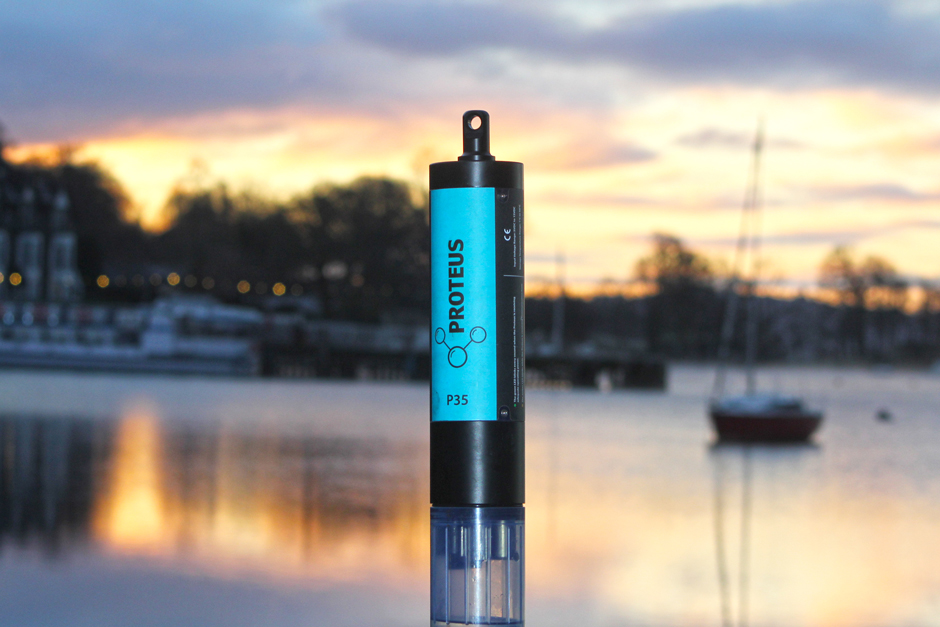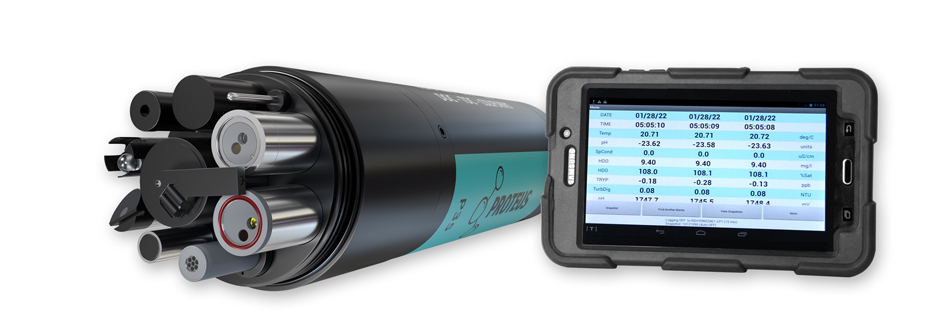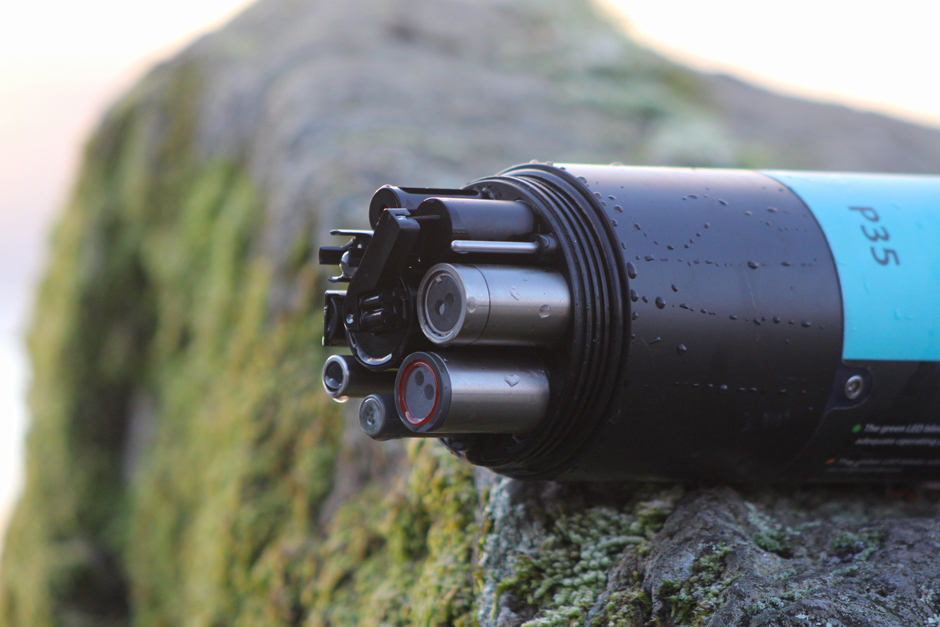It’s Time to React to Water Quality: Proteus Multiparameter Probe aboard NexSens Buoy
Water quality monitoring is essential for safeguarding public health, protecting ecosystems, and ensuring the sustainability of water resources. Contaminants such as industrial pollutants, agricultural runoff, and sewage discharge can severely impact aquatic life and pose serious risks to human health if left unchecked.
Traditionally, water quality monitoring has been a slow and labor-intensive process, requiring samples to be collected, transported to a lab, and analyzed—a process that can take days.
However, with the advancement of real-time sensor technology, environmental agencies, researchers, and industries can now monitor water quality instantly.
One of the most innovative solutions in this field is the Proteus multiparameter probe, a water quality probe designed to provide real-time data on Biochemical Oxygen Demand (BOD), Chemical Oxygen Demand (COD), Total Organic Carbon (TOC), and E. coli —key indicators of organic pollution. When paired with a NexSens buoy system, these sensors become even more powerful, enabling continuous monitoring in freshwater and coastal environments.

The Proteus multiparameter probe is designed to provide real-time water quality measurements – Biochemical Oxygen Demand (BOD), Chemical Oxygen Demand (COD), Total Organic Carbon (TOC), and E. coli. (Credit: Proteus)
The Need for Real-Time Water Monitoring
Traditional water sampling methods often leave a critical time gap between contamination events and response efforts. The Proteus multiparameter probe, however, offers an immediate and continuous stream of data, helping users detect pollution in real-time.
Rob Stevens, Managing Director at RS Hydro (parent company of Proteus Instruments), states, “The days of waiting five days for a lab result are over […] Now, we can see water quality changes as they happen—and that changes everything.”
For decades, the standard approach to measuring BOD—a critical indicator of organic pollution in water—has been a five-day lab-based test. This method, while widely accepted, is fraught with inefficiencies.
Stevens explains, “The whole background to getting a sample is swamped with massive problems, ranging from sample preparation and sample collection through to transportation and the laboratory test itself. From the moment you take the sample, you have to follow a military-style process: using a perfectly clean bottle, getting it to the lab immediately, keeping it below 4 deg C, and avoiding weekends when samples are often refrigerated and deteriorating for an extra couple of days. Even then, you’d be lucky if you got a reading within 20-30% accuracy.”
Similarly, traditional methods for detecting E. coli in water involve growing bacteria cultures on agar plates and counting colonies—a process that is both slow and prone to human error.
Stevens states, “One of our biggest challenges is that people assume lab results are always accurate. But all the steps leading up to that reading can introduce multiple sources of error. You might get a lab result of 10,000, but the real number could have been 10.”
How the Proteus Multiparameter Probe Works
The Proteus multiparameter probe combines optical and electrochemical sensors to measure multiple water quality parameters, including:
| Water temperature | Blue-green algae |
| pH | Rhodamine |
| ORP | Crude oil |
| Conductivity | Refined oil |
| Turbidity | CDOM / FDOM |
| Water depth | Fluorescein |
| Water level | Optical brighteners |
| Chlorophyll a | Tryptophan |
And automatically derived:
- Salinity
- TSS
- BOD/COD/TOC/DOC
- Total Coliform Monitoring (E. coli, total or fecal)
One of its most important technologies is its industry-leading fluorometric detection of tryptophan-like fluorescence (TLF), which acts as a direct indicator of organic pollution from sources like sewage or industrial discharge.
Proteus takes a completely different approach using fluorescence-based technology to deliver real-time BOD and E. coli measurements. By firing a highly filtered wavelength of light into the water, the Proteus probe can detect specific organic molecules based on how they absorb and re-emit energy.

A Proteus multiparameter sensor and handheld with a readout of parameter measurements displayed. (Credit: Proteus)
Stevens explains, “With fluorescence, we send out a targeted wavelength—say 285 nanometers—and if the right target molecules are present, they will emit light at a known and specific wavelength, which we can then measure. It’s much more precise than other optical methods like UV-Vis, which are not as precise and cannot measure E.coli.”
Research by Khamis et al. (2017) shows that TLF measurements are affected in the environment by:
- Temperature affects TLF through collisional quenching of the signal
- Turbidity: Different-sized suspended particles can amplify or attenuate fluorescing signals
- Other organic compounds can fluoresce at similar wavelengths and present as interferences
With this combination of parameters, early modeling by Khamis et al. (2017) demonstrated that dissolved oxygen concentration can be predicted with R² = 0.92 and biological oxygen demand with R² = 0.95.
The standard Proteus multiparameter probe measures specific biological activity using a model of the parameters from the sensors—temperature, turbidity, tryptophan, and Chromophoric Dissolved Organic Matter CDOM – light (Vis and UV) absorbing fraction of DOC.
Calibration and Long-term Performance of the Proteus Probe
It is recommended that for long-term installations, a site calibration be done to improve the accuracy of measurements. For the best results, Proteus recommends doing this with calibration samples from accredited laboratories. This can be an involved process that Proteus offers as a service, as well as advice in performing this solo.
The Proteus multiparameter probe features a self-cleaning wiper. This prevents biofouling (algae or sediment buildup) on the sensors, making it ideal for long-term deployments.

Proteus multiparameter sensor close up of self-cleaning wiper. (Credit: Proteus)
A Real-time Solution
The current methods of laboratory tests are time-consuming and expensive. Microbial contamination is often episodic, meaning traditional methods can miss short-term pollution spikes. Real-time monitoring alleviates the resource intensiveness of the process and increases the time to react.
Khamis et al. (2017) shows the incredible accuracy for measuring water quality with this technology, but it also shows how results can be compromised by unexpected microbiological activity. However, a false positive must be compared with the alternative of potentially not measuring at all. The ability to be alerted in real-time means that issues can be addressed before they get worse.
Why NexSens Buoys Are the Ideal Deployment Solution
Deploying a Proteus multiparameter probe in the field requires a stable and reliable platform, especially for long-term monitoring. NexSens buoys provide an ideal deployment solution, offering a combination of rugged design, real-time telemetry, and solar-powered operation to ensure continuous data collection in remote or harsh environments.
Some key advantages of NexSens buoy systems include:
- Durable Construction – Built to withstand extreme weather conditions, strong currents, and prolonged exposure to water.
- Integrated Telemetry – Allowing seamless real-time data transmission via cellular, satellite, or radio communication.
- Solar Power – Providing continuous power for extended deployments without the need for frequent maintenance.
- Flexible Mounting Options – Designed to accommodate multiple sensors, including the Proteus probe, without interfering with data accuracy.
Stevens states that “The NexSens CB-450 has been in the water since August 2022 and the three 15-watt solar panels provide more than enough to power for the Proteus probe an the telemetry. These buoys have also weather some very significant storms without any issues. We visit the buoys every three months for calibration, but otherwise, it’s self-sustaining.”
The copper antifouling is also replaced during our routine visits.
One of the biggest advantages of using the NexSens buoy is its pass-through design, which allows sensors to be easily removed and serviced without needing to take the entire system out of the water.
Stevens explains, “We chose the CB-450 because of its cut-throughs—it means we can just pull the sensor out, calibrate it, and put it back in without having to lift the whole buoy. It’s a game-changer for deployment and maintenance in marine environments.”
Seamless Data Integration and Remote Access
The Proteus multiparameter probe and NexSens buoy work synergistically to deliver high-quality, real-time data that can be easily integrated into remote monitoring systems.
The Proteus multiparameter probe supports SDI-12 and RS-485 Modbus protocols, making it simple to connect to NexSens data loggers, which then transmit the data wirelessly.
This setup allows researchers and environmental managers to access live water quality readings from anywhere, whether through a web dashboard, cloud-based platform, or dedicated monitoring software.
As industries, governments, and research organizations push for more efficient and accurate water quality monitoring, the integration of advanced sensors like the Proteus multiparameter probe with robust buoy platforms like NexSens is setting a new standard for environmental monitoring.




0 comments